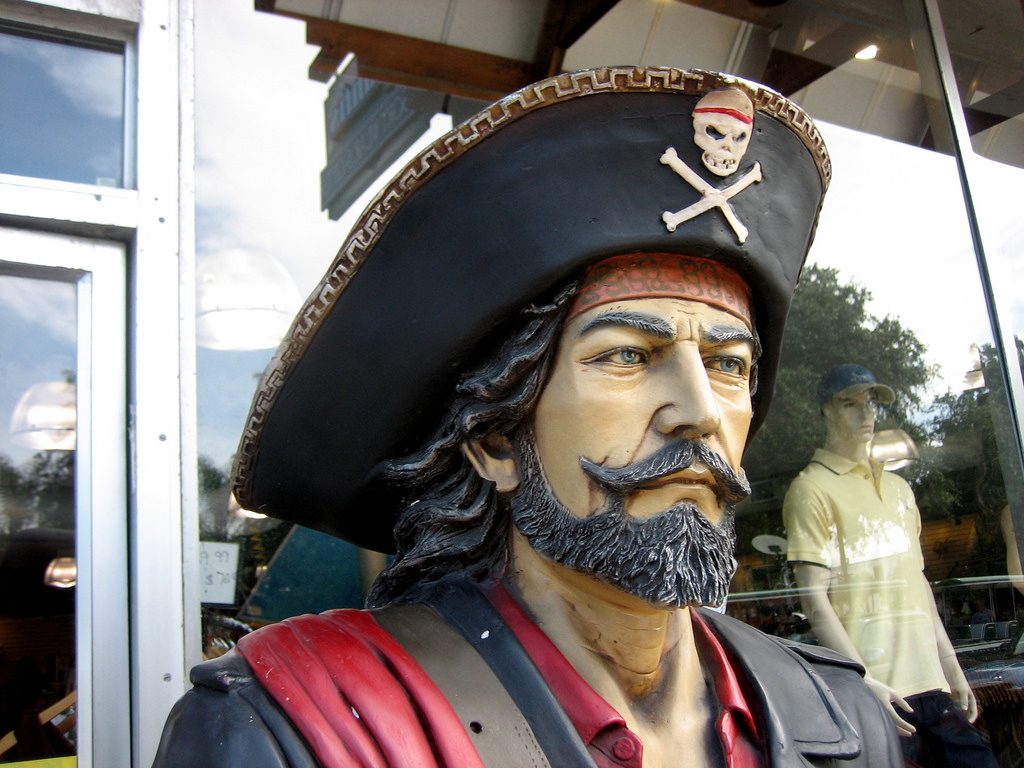
CC Attribution License
September 19th was “Talk Like a Pirate Day.” In honor of the occasion, we’ve scored a bounty of good books–true tales, all–about pirates, both historical and present-day. Drop anchor at PPL and check out a few of these titles, or dig up some literary treasure of your own. Happy reading!
Pirates of Barbary: Corsairs, Conquests, and Captivity in the Seventeenth Century Mediterranean by Adrian Tinniswood
Delivers the stirring story of the 17th-century pirates of the Mediterranean–the forerunners of today’s bandits of the seas–and how their conquests shaped the clash between Christianity and Islam.
It’s easy to think of piracy as a romantic way of life long gone–if not for today’s headlines of robbery and kidnapping on the high seas. Pirates have existed since the invention of commerce itself, but they reached the zenith of their power during the 1600s, when the Mediterranean was the crossroads of the world, and pirates were the scourge of Europe and the glory of Islam. They attacked ships, enslaved crews, plundered cargoes, enraged governments, and swayed empires. Historian Adrian Tinniswood brings alive this chapter in history, where clashes between pirates of the East–Tunis, Algiers, and Tripoli–and governments of the West–England, France, Spain, and Venice–grew increasingly intense and dangerous, and he shows how their maneuverings betweenthe Muslim empires and Christian Europe shed light on the religious and moral battles that still rage today.
The Pirate Hunter: The True Story of Captain Kidd by Richard Zacks
A Captain’s Duty: Somali Pirates, Navy SEALs, and Dangerous Days at Sea by Richard Phillips with Stephan Talty; read by George K. Wilson
It was just another day on the job for fifty-three-year-old Richard Phillips, captain of the Maersk Alabama, a United States-flagged cargo ship that was carrying, among other things, food and agricultural materials for the World Food Program. That all changed when armed Somali pirates boarded the ship. The pirates didn’t expect the crew to fight back, nor did they expect Captain Phillips to offer himself as a hostage in exchange for the safety of his crew. Thus began the tense five-day standoff, which ended in a daring high-seas rescue when U.S. Navy SEALs opened fire and picked off three of the captors.
“It never ends like this,” Captain Phillips said. And he’s right.
A story of adventure and courage, A Captain’s Duty provides the intimate details of this high-seas hostage-taking–the unbearable heat, the death threats, the mock executions, and the escape attempt. When the pirates boarded his ship, Captain Phillips put his experience into action, doing everything he could to safeguard his crew. And when he was held captive by the pirates, he marshaled all his resources to ensure his own survival, withstanding intense physical hardship and an escalating battle of wills with the pirates. This was it: the moment where training meets instinct and where character is everything. Richard Phillips was ready.
Examines the role of citizen privateers, seamen who raided British trade ships around the Atlantic Ocean, in America’s battle for independence from Britain, detailing their strategic and political significance, as well as the part they played in the slave trade.
They were legalized pirates empowered by the Continental Congress to raid and plunder, at their own considerable risk, as much enemy trade as they could successfully haul back to America’s shores; they played a central role in Americans’ struggle for independence and later turned their seafaring talents to the slave trade; embodying the conflict between enterprise and morality central to the American psyche.
Jay Bahadur, a journalist who dared to make his way into the remote pirate havens of Africa’s easternmost country and spend months infiltrating their lives, gives us the first close-up look at the hidden world of the pirates of war-ravaged Somalia.
Bahadur’s riveting narrative exposé–the first ever–looks at who these men are, how they live, the forces that created piracy in Somalia, how the pirates spend the ransom money, how they deal with their hostages. Bahadur makes sense of the complex and fraught regional politics, the history of Somalia and the self-governing region of Puntland (an autonomous region in northeast Somalia), and the various catastrophic occurrences that have shaped their pirate destinies. The book looks at how the unrecognized mini-state of Puntland is dealing with the rise–and increasing sophistication–of piracy and how, through legal and military action, other nations, international shippers, the United Nations, and various international bodies are attempting to cope with the present danger and growing pirate crisis.
From David Cordingly, one of the world’s foremost experts on pirate history, and author of the perennial favorite Under the Black Flag, comes the thrilling story of the man who fought the real pirates of the Caribbean. Sea captain, privateer, and colonial governor, Woodes Rogers was one of the early eighteenth century’s boldest and most colorful characters. Pirate Hunter of the Caribbean is the definitive account of his incredible life.
At a time when Europe’s maritime nations fought over islands and territories, and pirates and other scoundrels were flourishing, Rogers sailed into the center of the action. In 1708, in the midst of Britain’s war with Spain, Rogers was hired to lead a mission against Spanish targets in the Pacific. A fearless adventurer who lost his fortune as often as his temper, he battled scurvy and hurricanes and mutinies—and along the way captured a treasure galleon and rescued the shipwrecked Alexander Selkirk, whose four-year ordeal on a remote Pacific island inspired Daniel Defoe to write Robinson Crusoe.
When the Treaty of Utrecht in 1713 led to an explosion of piracy in the Caribbean, King George I appointed Rogers governor of the Bahamas. There he found himself in charge of a string of islands being plundered by raucous felons, from the notorious “Blackbeard,” who kept lit matches under his hat to give himself a hellish cast, to Charles Vane, a particularly brutal pirate captain, to Anne Bonny and Mary Read, rare female pirates who escaped the hangman’s noose only by revealing their pregnancies.
With rich and vivid details and plenty of action, David Cordingly chronicles a rollicking adventure that is as fascinating and gripping as any seafaring legend.
Jean and Pierre Laffite’s lives were intertwined with the most colorful period in New Orleans’ history, the era from just after the Louisiana Purchase through the War of 1812. Labeled as corsairs and buccaneers for methods that bordered on piracy, the brothers ran a privateering cooperative that provided contraband goods to a hungry market and made life hell for Spanish merchants on the Gulf. Later they became important members of a syndicate in New Orleans that included lawyers, bankers, merchants, and corrupt U.S. officials. But this allegiance didn’t stop them from becoming paid Spanish spies, handing over information about the syndicate’s plans and selling out their own associates.
In 1820 the Laffites disappeared into the fog of history from which they had emerged, but not before becoming folk heroes in French Louisiana and making their names synonymous with piracy and intrigue on the Gulf.
The definitive biography of history’s most fearsome and famous pirate.
Of all the colorful cutthroats who scoured the seas in search of plunder during the Golden Age of Piracy in the early eighteenth century, none was more ferocious or notorious than Blackbeard. As unforgettable as his savage career was, much of Blackbeard’s life has been shrouded in mystery–until now.
Drawing on vivid descriptions of Blackbeard’s attacks from his rare surviving victims, pirate expert Angus Konstam traces Blackbeard’s career from its beginnings to his final defeat in a tremendous sea battle near his base at Ocracoke Island. Presenting dramatic accounts of the pirate’s very effective tactics and his reputation for cruelty, Konstam offers a fascinating examination of the life and business of piracy and the lure of this brutal and bloody trade.
